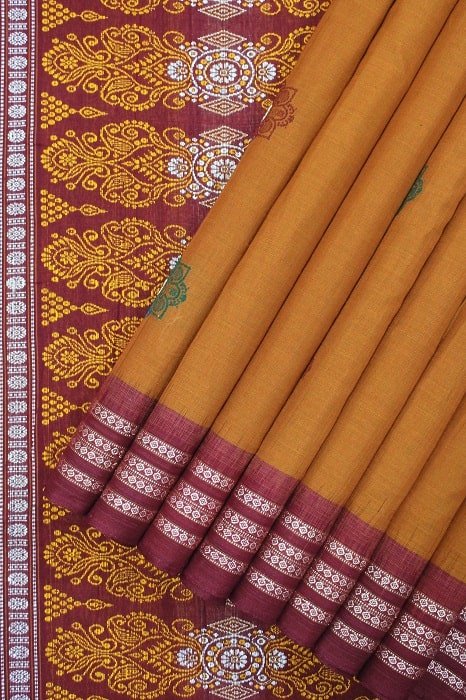ॐ श्री गुरुभ्यो नमः ॐ श्री शिवानन्दाय नमः ॐ श्री चिदानन्दाय नमःॐ श्री दुर्गायै नमः
Source of all Images in this Blog-post : Google Images : ‘Google Image Search’ will reveal the multiple sources of every single image shared here. For more details, kindly see ‘Disclaimer‘
Bomkai: Draped in traditions of Odisha
Among Odisha’s wide variety of textiles, the Bomkai, which gets its name from the village it is woven in, stands out for its intricate & luxurious weft.
Like the Sambalpuri weave, the name Bomkai is synonymous with Odisha.

This state is famous for its textile heritage and history that goes back to as early as 600 BC.
The Bhulia community, associated with weaving, is the one involved in the production of Bomkai Sarees.
Bomkai originates in the village of the same name, in Ganjam district of Odisha. Also known as Sonepuri Sarees, they are made across the southern coastal plains and in Sonepur of western Odisha.

These Sarees were worn by the royalty, the aristocracy and the Brahmins of Ganjam in ancient times.
The unique aspect of these Sarees is the intermixing of the two techniques of tie-and-dye and embroidery.
Bomkai employs Ikat (binding) as well as detailed needle-work on the Pallus. Such intricate thread work is made on bright, contrasting backgrounds.

Weaving Legacy into Bomkai
Bomkai Sarees are made in both cotton and silk and the motifs and designs are inspired from nature and tribal art forms.
Bomkai Sarees uses motifs that are quite uncommon when compared to the ubiquitous and most used designs of traditional Indian weaves.
The designs are composed of beautiful motifs including Karela (Bitter gourd), Kanthiful (small flower), Padma (Lotus), Rui Rachha (carp fish), Koinchha (tortoise), Mayur (Peacock) and Chadhei (bird) in geometrical pattern.
The design of fish is very popular as it is believed to be a sign of success and affluence. A row of Kumbha (a water pot) is also one of the most popular border motifs on Bomkai Silk.
Bomkai still retains the original technique of weaving and has not shifted entirely to the jacquard and dobby techniques like many other weaving traditions.
There are about a thousand families in the village of Bomkai, where all family members still depend on different kinds of handloom work for livelihood, including Bomkai weaving.

Embracing Modernization
Once Bomkai Sarees started using Zari (threads made of gold or silver), it increased its popularity and led to an increase in Bomkai’s market demand and value.
Weavers began to use the Zari as a base on which the rest of the threadwork was done and the sparkling base helps create a newer style.
Some of the famous varieties that are based on Bomkai and Zari weave include Sonepuri, Pasapali, Barpali and Bapta.
In addition to traditional Sarees, contemporary weavers also make other garments like suits, stoles, shawls and so on to cater to a younger market.
There is an encouraging trend for handloom in domestic as well as international market today and the craftsmen are putting their best forward to be a part of it.

Bollywood and Bomkai
The present day Bomkai Sarees are a result of many innovations and have a very strong hold on the market of luxury garments.
One can easily see many big Bollywood actresses or politicians wering Bomkai Sarees, especially with Zari works.
These Sarees are a luxury right now. Every time there is an award show or a wedding coming up in the Bollywood, there is an unprecedented increase in the demand for Bomkai Sarees.
Bollywood’s obsession with Bomkai Saree is clear from the fact that a Bomaki Saree, called Radhakunja, designed by Chaturbhuj Meher at Sonepur, was worn by actor Aishwarya Rai Bachchan for her wedding.
Because it is considered auspicious, the Brahmins of the southern part of Odisha wear only Bomkai Sarees on religious occasions. And, of course, it is the preferred Saree of Odissi dancers around the world.
Odisha’s expertise in weaving handloom is unparalleled in the country. Whether it is Bomkai, Ikat or Pasapalli, the ubiquitous handloom is identifiable with the state’s rich culture and traditions.
The modern-day challenge, however, has been how to contemporise handloom without taking away from the warp and weft for which it is sought after, and the weavers from Odisha have done it beautifully.




